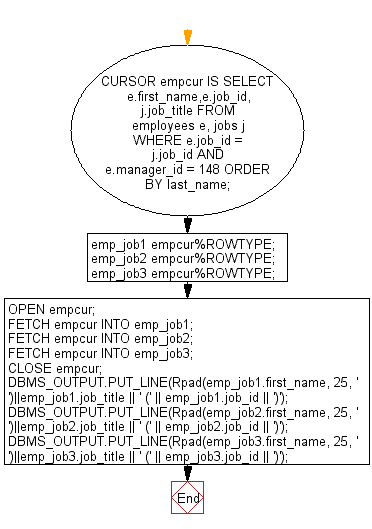PL/SQL Cursor Exercises: Fetch the first three rows of a result set into three records using Same explicit cursor into different variables
PL/SQL Cursor: Exercise-26 with Solution
Write a program in PL/SQL to fetch the first three rows of a result set into three records using Same explicit cursor into different variables.
Sample Solution:
Table: employees
employee_id integer first_name varchar(25) last_name varchar(25) email archar(25) phone_number varchar(15) hire_date date job_id varchar(25) salary integer commission_pct decimal(5,2) manager_id integer department_id integerTable: jobs
job_id varchar(25) job_title varchar(50) min_salary integer max_salary integer
PL/SQL Code:
DECLARE
CURSOR empcur IS
SELECT e.first_name,e.job_id, j.job_title
FROM employees e, jobs j
WHERE e.job_id = j.job_id AND e.manager_id = 148
ORDER BY last_name;
emp_job1 empcur%ROWTYPE;
emp_job2 empcur%ROWTYPE;
emp_job3 empcur%ROWTYPE;
BEGIN
OPEN empcur;
FETCH empcur INTO emp_job1;
FETCH empcur INTO emp_job2;
FETCH empcur INTO emp_job3;
CLOSE empcur;
DBMS_OUTPUT.PUT_LINE(Rpad(emp_job1.first_name, 25, ' ')||emp_job1.job_title || ' (' || emp_job1.job_id || ')');
DBMS_OUTPUT.PUT_LINE(Rpad(emp_job2.first_name, 25, ' ')||emp_job2.job_title || ' (' || emp_job2.job_id || ')');
DBMS_OUTPUT.PUT_LINE(Rpad(emp_job3.first_name, 25, ' ')||emp_job3.job_title || ' (' || emp_job3.job_id || ')');
END;
/
Sample Output:
SQL> / Elizabeth Sales Representative (SA_REP) Harrison Sales Representative (SA_REP) Tayler Sales Representative (SA_REP) PL/SQL procedure successfully completed.
Flowchart:

Go to:
PREV : Write a program in PL/SQL to show the uses of fetch one record at a time using fetch statement inside the loop.
NEXT : Write a PL/SQL block to show the uses of a variable in explicit cursor query, and no result set is affected
despite that value of the variable is incremented after every fetch.
Improve this sample solution and post your code through Disqus
What is the difficulty level of this exercise?
